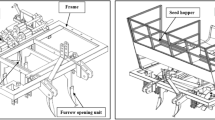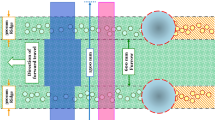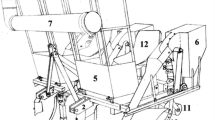Abstract
A tractor operated sugarcane cutter planter was designed and developed at ICAR-Indian Institute of Sugarcane Research, Lucknow (IISR) for planting of sugarcane. It was equipped with deep furrow opener to facilitate furrow method of sugarcane planting. The designed planter consisted of deep furrow opener, sharp edged blades to cut whole cane into 350 mm long pieces as seed material, metering device for application of fertiliser and insecticide, soil covering shovels and tamping roller for pressing soil cover. It was a mounted type equipment rigidly attached with tractor through three-point linkage. Planter was pulled by the tractor and its cutting blades and fertiliser metering rollers were driven by tractor PTO shaft. Planter was field tested at IISR farm in sandy loam soil. At forward speed of 0.5 ms−1, mean overlapping between two successive setts were 72 mm, which was acceptable and well within the desired overlapping range of 50–100 mm for subtropical India. Effective field capacity (output) of the planter was 0.16 ha h−1. Its performance was compared with conventional method of planting. Depth of furrow was 250 mm in case of the planter as against 120 mm in conventional method. Mean soil covering depth over planted setts was 80 mm. Mean bud emergence improved by 3.7 % in case of the planter as compared to conventional planting. Only 25 labour-h ha−1 labour is involved for planting with the developed planter which is about 11 times less than the conventional method of planting (280 labour-h ha−1). Cost of planting operation was also saved by about 63 % using the developed planter.
Similar content being viewed by others
Avoid common mistakes on your manuscript.
Introduction
Sugarcane, an important cash crop, is cultivated in an area of about 5.3 million hectares in India, with an annual production of about 366 million tonnes (Anon 2016). Planting of sugarcane is highly labour and time intensive operation. It involves sett cutting for preparing seed material, furrow opening in field, placing seed-setts in furrows, mixing of fertiliser, application of insecticide and then coverage of setts with soil. These operations are arduous, energy, labour and drudgery intensive. Conventionally, opening of furrow using tractor operated ridgers are only mechanised operation and rest of the sugarcane planting operations are done manually. In addition to this, the bud damage due to excessive handling of seed cane, desiccation of setts and loss of soil moisture could hardly be checked. Conventionally, flat method of planting is practiced in North India. Furrow method of planting in deep furrows facilitates furrow irrigation which is the most efficient surface irrigation method. Furrow method of sugarcane planting also reduces the lodging of sugarcane due to better and deep root growth. It also helps in better ratooning. Efforts were made at ICAR-Indian Institute of Sugarcane Research, Lucknow (IISR) to develop individual machines for cutting setts and for planting them in the soil. Setts were dropped either manually in case of the IISR semi-automatic planter or mechanically with an automatic planter, which had mechanical device to feed straight cane setts. Attempts were made in Pakistan and at IISR, Lucknow to develop a suitable whole cane cutter planter. These planters were for planting of sugarcane in flat method (Khalid 1987; Sharma et al. 1995; Singh et al. 2011, 2016). In this method after cane planting field is levelled and method of irrigation followed is flood irrigation. In North India, recommended row spacing is 900 mm for autumn planting and 750 mm for spring planting. There was a need for development of a planting device for mechanising sugarcane planting to facilitate furrow planting and have provision for adjustment of row spacing of 750 or 900 mm. In view of the above, a new planting machine was designed, developed and field evaluated at IISR for performing all unit operations involved in sugarcane planting simultaneously in its single pass.
Materials and Methods
Development of the Planter
The planter consisted of furrow opening, sett cutting, fertiliser metering, power transmission, insecticide solution application and soil covering units (Fig. 1). All the units are mounted on rigid and sturdy mild steel (MS) framework. Detailed technical specification of the planter is presented in Table 1.
Schematic view of the sugarcane planter. 1 Furrow opener, 2 Main frame, 3 Telescopic propeller shaft, 4 Universal Joint Cross, 5 Reduction gear box, 6 Bevel gear box, 7 Three-point linkage, 8 Seed cane tray, 9 PVC Seat, 10 Insecticide solution tank, 11 Fertiliser box, 12 Soil covering reversible shovel and tamping roller
Furrow Opening Unit
Two furrow openers, one for each row, were mounted on MS frame. Provisions were made for adjustment of row spacing between two furrow openers either at 750 or 900 mm. Each furrow opener consisted of two mould board plough bottoms (mould board, share bar, share, landside) joined together (Fig. 2). The selected materials were 3 mm thick MS sheet for mould board, 3 mm thick high carbon steel for share, 25.4 mm × 25.4 mm square high carbon steel solid rod for share bar and 12 mm thick MS plate for landside.
Sett Cutting Unit
It consisted of two blades mounted on a rotating disc and a pair of guiding ring for each row. Whole canes are fed up to the depth of furrow bottom manually through the guiding ring to the rotating blades. The diameter of the guiding ring was 100 mm to facilitate feeding of even the bend cane stalks without any damage to the buds. Designed sett cutting blades were curved to provide sharp cut with minimum force (Fig. 3). The selected material for cutting blade was 3 mm thick high carbon steel. A safety cover was provided over the blades for avoiding any accident. Planter was designed to provide the desired overlapping of 50–100 mm of seed-setts at a tractor operating speed of 0.50 ms−1. Seed box was designed to accommodate 100 kg of whole seed cane.
Fertiliser Metering Unit
Fertiliser metering unit consisted of MS fertiliser box, PVC casings, PVC edge cell circular rotors and PVC pipe to guide the metered fertiliser to the desired location in furrow bottom. Rate of fertiliser was regulated by adjusting the clearance gap between the casing and rotor within allowable range. For further variation of rate of fertiliser different size rotors could be selected. The capacity of each fertiliser box was 20 kg.
Power Transmission Unit
Sett cutting and fertiliser metering units were powered through tractor power take off (PTO) shaft (Fig. 4). Tractor PTO power was transmitted to sett cutting blades through universal joint crosses, propeller shaft, reduction gear box and bevel gear box. Power from output shaft of reduction gear box was transmitted to fertiliser metering rollers through chain and sprockets.
Schematic view of power transmission from tractor PTO to sett cutting and fertiliser metering rollers. 1 Power from PTO shaft, 2 Universal Joint Cross, 3 Reduction gear box (15:1), 4 Bevel gear box (1:1.8), 5 Cutting blade, 6 Driving chain-sprocket (32 T), 7 Driven chain-sprocket (16 T), 8 Fertiliser metering roller
Insecticide Solution Application Unit
PVC pipe of 200 mm diameter and 1150 mm length was attached with the main frame for insecticide solution. Liquid solution was applied over setts in furrow through PVC pipe under gravity force. A gate valve was also provided to regulate the chemical solution application. An arrangement was made to distribute the solution in five peaks before falling over the setts. The capacity of the insecticide solution storing pipe was 35 l.
Sett Covering Unit
It consisted of covering tynes with reversible shovels and a tamping roller for each row on a ‘U’ frame. While sett covering was provided with the help of shovels, the tamping roller was used to press the blanket of soil lightly for conserving the soil moisture.
The planter was fabricated in the workshop of Agricultural Engineering Division of IISR. In addition to the above sub units, the equipment was provided with two seats for feeding the seed canes. All the moving parts were guarded to avoid any accident.
Field Evaluation of the Planter
Performance of the planter was evaluated in the field of IISR located at 26°56′N, 80°52′E and 111 m above sea level with semi arid subtropical climate having dry hot summer and cold winter. The soil of the field was sandy loam (14 % clay, 26 % silt and 60 % sand) of Indo-Gangetic alluvial origin, pH 7.6, very deep (>2 m), well drained, flat and classified as non-calcareous mixed hyper thermic udic ustochrept. Performance trials of the planter were conducted in 10 ha fields during 2014–2015 and 2015–2016 (Fig. 5). Crop parameters like variety, average length and weight of whole seed cane stalks, field parameters like length and width of field were recorded. Performance of the planter was compared with conventional method of planting i.e. furrow opening by tractor operated ridger and rest of the operations including sett cutting manually. A 30 kW tractor was used for operating the planter as well as conventional ridger.
Performance Parameters
Planter performance parameters like sett length, number of setts cut and dropped per m length of furrow, depth of furrow, depth of soil cover, wheel slippage of tractor were recorded. Time utilisation study (Singh and Mani 2006) was conducted for recording the time utilised in different activities of sugarcane planting i.e. time lost in turning of planter at head land, filling of seed, fertiliser, insecticide solution and miscellaneous activities. Following mathematical relationships were used for analysing the performance results;
where tl percentage of total planter operation time lost in turning, filling of seed, fertiliser and insecticide solution and miscellaneous time loss, decimal.
Cost of Operation
Total cost of planting operation was analysed by adding the fixed and variable cost of the tractor and planter. The parameters used in the analysis of cost components were either based on the actual performance data of the planter or as Bureau of Indian Standards (Anon 1979) for estimation of cost of farm machinery operations. Values of different parameters used during cost analysis are presented in Table 2.
Results and Discussion
Performance of the Planter
Once the prototype was fabricated and its main components fully operational, it was rigorously evaluated at the workshop. A pre-field test performance was carried out, simulating its probable behaviour in the field for various operational settings. Field testing of the planter was conducted in the sandy loam soil of IISR farm at row spacing of 750 mm. Field performance results are presented in Table 3. Mean value of cut seed-sett length was 363 mm. At forward speed of 0.5 ms−1, mean overlapping between two successive setts was 72 mm, which was well acceptable and within the desired overlapping range of 50–100 mm for subtropical India. When forward speed of the tractor increased speed ratio of sett cutting blade and tractor decreased resulting in decreased overlapping between planted setts. Mean tractor wheel slippage at load was 5.2 %. With the increase in tractor wheel slippage overlapping between planted setts increased due to increased speed ratio of sett cutting blade and tractor.
Output of the Planter
The mean theoretical field capacity and effective field capacity of the planter was 0.27 and 0.16 ha h−1, respectively. The effective field capacity of the planter was low because of low forward speed (0.50 ms−1) of the tractor for maintaining the desired overlapping of setts and large time lost in refilling of seed cane (6000 kg ha−1), fertiliser (>300 kg ha−1), insecticide solution (800 l ha−1), turning of the planter at the headland, minor breakdown, operator personal time, etc. The total time lost in the above was 41 % of the total operating time of the planter. The effective field capacity of the planter (output) varied with the field and crop parameters. For less field length, number of headland turning increased, resulting in increased time lost in turning. Similarly, for small seed cane length seed tray accommodate less seed resulting in increased time lost in refilling of seed.
Comparative Performance with Conventional Method of Planting
Performance of the planter was compared with conventional planting. The results are presented in Table 4. Planter performed all the unit operations involved in sugarcane planting including sett cutting simultaneously in single pass of the machine. In conventional system, tractor operated ridger is used for furrow opening and rest of the operations are performed manually including sett cutting. Bud damage was 1.5 % more in the planter due to blind cutting mechanism. However, bud emergence improved by 3.7 % in case of the planter as compared to conventional planting because of saving of soil as well as seed moisture due to simultaneous operations of sett cutting, furrow opening and soil covering with the planter. Depth of planting was 250 mm for the planter as against 120 mm in conventional flat method. Depth of furrow intact after soil covering was 120 mm (250 mm if height of ridge, which is formed due to piling of soil coming out during furrow opening, is also added) in the field planted by the planter which facilitated furrow method of irrigation. Furrow method of irrigation is an improvement over the conventional flat method in terms of increased water use efficiency and saving of irrigation water.
Economics
Cost of planting operation per ha was ₹ 2740 in case of the sugarcane planter as against ₹ 7380 in conventional planting. Four labours are required for smooth operation of the planter, two for feeding seed canes through guiding rings for sett cutting and remaining two to fill the planting inputs like seed, fertiliser and insecticide solution. Only 25 labour-h ha−1 was required for planting using the developed sugarcane planter (planter effective field capacity 0.16 ha h−1) which is about 11 times less than the labour requirement in conventional planting (280 labour-h ha−1). It is imperative from the above that there was a saving of about 63 % in cost of operation and 91 % in labour requirement in case of the developed planter. In addition to that planter reduces the human drudgery involved in sugarcane planting operations.
Conclusions
A new multifunctional planter was designed and developed for mechanising furrow method of sugarcane planting. During field trials, its mean effective field capacity (output) was 0.16 ha h−1 at a forward speed of 0.5 ms−1 with average overlapping of 72 mm between two successive planted setts. Depth of planting was 250 mm as against the 120 mm in conventional method. Only 25 labour-h ha−1 labour is involved for planting with sugarcane planter which is about 11 times less than the conventional method of planting (280 labour-h ha−1). Cost of planting operation reduced by about 63 % and mean bud emergence improved by 3.7 % in case of the developed planter as compared to conventional planting.
References
Anon. 2016. Statement showing figures of area under sugarcane, yield of sugarcane, production of sugarcane, number of factories, working capacity, cane crushed, recovery, sugar production, duration and molasses production from 1930–31 to 2014–15. Indian Sugar LXVII(1): 56–57.
Anon. 1979. Guide for estimating cost of farm machinery operation (IS: 9164-1979). New Delhi: Indian Standard Institution.
Khalid, M. 1987. Design of FMI sugarcane planter. Agricultural Mechanization in Asia, Africa and Latin America 18(2): 67–68.
Sharma, M.P., A.K. Singh, and A.C. Srivastava. 1995. Tractor drawn sugarcane cutter planter. Invention Intelligence 30(11): 518–525.
Singh, A.K., and I. Mani. 2006. Computer simulation of mechanical harvesting and transportation of sugarcane. Journal of Agricultural Engineering 43(3): 87–92.
Singh, J., A.K. Singh, M.P. Sharma, P.R. Singh, and A.C. Srivastava. 2011. Mechanization of sugarcane cultivation in India. Sugar Tech 13(4): 310–314.
Singh, S., P.R. Singh, A.K. Singh, and R. Gupta. 2016. Present status and future need of mechanizing sugarcane cultivation in India. Agricultural Mechanization in Asia Africa and Latin America 47(1): 75–81.
Acknowledgments
Authors are thankful to the Technicians of Division of Agricultural Engineering, ICAR-Indian Institute of Sugarcane Research, Lucknow for their help and support in fabrication and testing of the prototype. Financial help received during the course of study from the employer institute i.e. ICAR-Indian Institute of Sugarcane Research, Lucknow is duly acknowledged.
Author information
Authors and Affiliations
Corresponding author
Ethics declarations
Conflict of interest
The authors declare that they have no conflict of interest.
Rights and permissions
About this article
Cite this article
Singh, A.K., Singh, P.R. Development of a Tractor Operated Sugarcane Cutter Planter for Mechanisation of Sugarcane Planting in Deep Furrows. Sugar Tech 19, 416–423 (2017). https://doi.org/10.1007/s12355-016-0471-9
Received:
Accepted:
Published:
Issue Date:
DOI: https://doi.org/10.1007/s12355-016-0471-9









